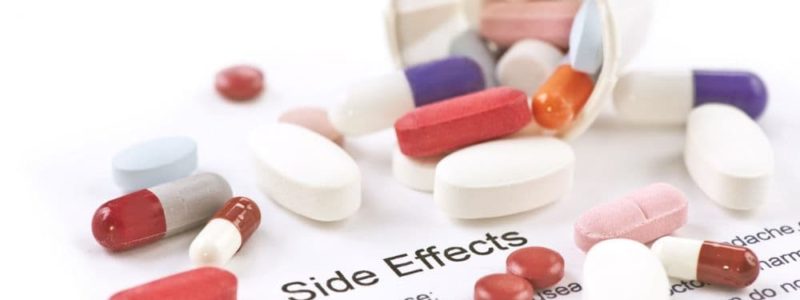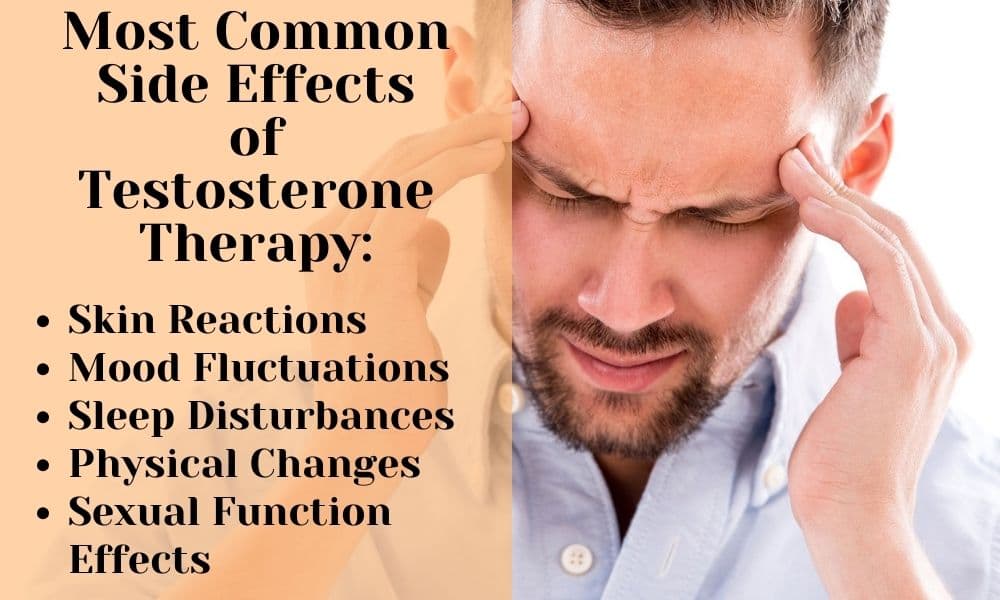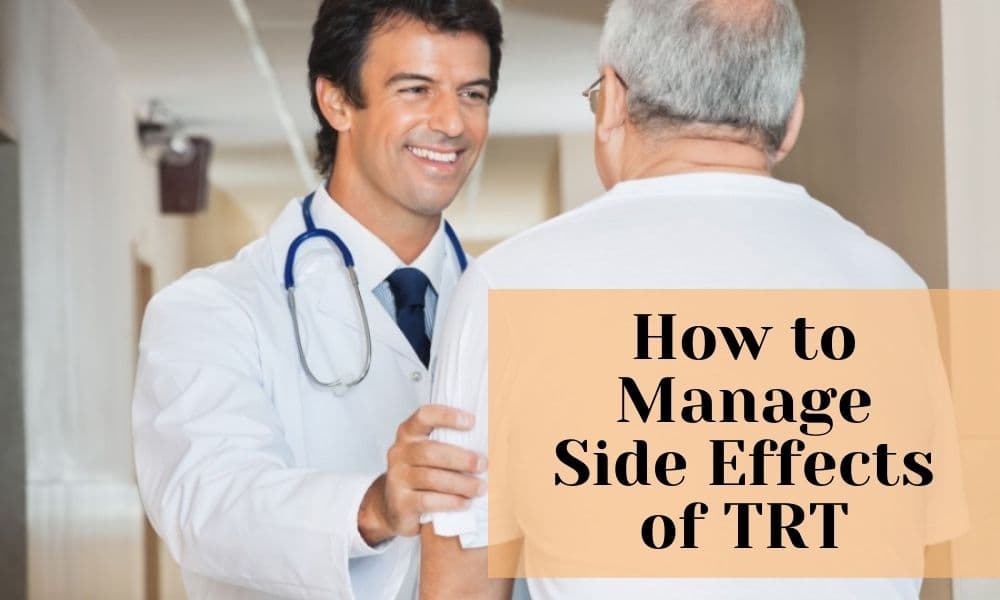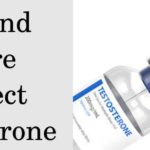Testosterone replacement therapy (TRT) is a form of hormone replacement therapy, that involves administering testosterone to treat conditions caused by low levels of this hormone in men. This therapy is primarily used to address hypogonadism, where the body fails to produce adequate testosterone, essential for male growth and development.
The benefits of testosterone therapy are significant, including improved energy levels, increased muscle mass, enhanced sexual function, and better mood and cognitive function. However, it’s crucial to understand the potential side effects, which can range from mild to severe.
These may include acne, sleep apnea, increased red blood cell count, prostate enlargement, and potential cardiovascular risks. Understanding these side effects is vital for patients and healthcare providers to make informed decisions about the therapy’s appropriateness and to manage any adverse effects effectively.
What is Testosterone Therapy?
Testosterone therapy stands as a vital treatment in the field of endocrinology, mainly aimed at addressing male hypogonadism, a condition characterized by the body’s inadequate production of testosterone. This hormone is essential in male health, significantly impacting sexual maturation, reproductive capabilities, and muscle strength.
TRT is primarily prescribed for men who have clinical symptoms of low testosterone and confirmed by blood tests showing deficiency. Common symptoms include reduced libido, fatigue, muscle weakness, and mood disturbances.
It’s also indicated in certain cases of delayed puberty in boys and may be considered in older men with significantly low testosterone levels, although this is a more nuanced decision.
Testosterone exerts its effects through several mechanisms. It binds to androgen receptors in target tissues, influencing gene expression and stimulating protein synthesis, crucial for muscle growth and maintenance.
In the bones, it promotes bone formation and decreases bone resorption, aiding in maintaining bone density. Testosterone also plays a vital role in sexual function, influencing libido and erectile function. Additionally, it has significant effects on mood and cognitive function, although these pathways are less well understood.
Forms of Testosterone Replacement Therapy
- Gels: Applied daily to the skin, allowing testosterone to be absorbed directly into the bloodstream. They are convenient but require care to prevent skin-to-skin transfer to others.
- Injections: Testosterone can be injected into the muscle, typically every two to three weeks. This method ensures direct entry into the bloodstream but can cause fluctuations in hormone levels.
- Patches: Applied daily on the skin, these release testosterone gradually. They are convenient but may cause skin irritation in some users.
The Most Common Side Effects of Testosterone Therapy
Testosterone therapy, while beneficial for many, can also lead to a range of side effects. Understanding these is crucial for patients undergoing treatment and their healthcare providers.
Skin Reactions
One of the most common side effects is changes in the skin. Patients may experience increased oiliness, which can lead to acne outbreaks. This occurs because testosterone stimulates the sebaceous glands in the skin, increasing oil production.
Mood Fluctuations
Testosterone plays a significant role in mood regulation. Therapy can sometimes lead to mood swings, irritability, or increased aggression. These effects are believed to be due to the direct impact of testosterone on the brain, particularly in areas that regulate mood and behavior.
Sleep Disturbances
Sleep apnea, a condition characterized by pauses in breathing during sleep, can be exacerbated or even initiated by testosterone therapy. This is particularly concerning as sleep apnea can lead to long-term cardiovascular risks.
Physical Changes
Patients often experience physical changes, including weight gain and increased muscle mass. While muscle growth is generally a desired effect, weight gain can sometimes be in the form of increased body fat. Monitoring diet and exercise is crucial during therapy.
Sexual Function Effects
Testosterone has a complex relationship with sexual function. While therapy can enhance libido and improve erectile dysfunction in men with low testosterone, it can paradoxically lead to decreased libido or other sexual dysfunctions in some individuals.
This is due to the delicate balance of hormones required for optimal sexual function, which can be disrupted by external testosterone administration.
It’s important to note that the severity and occurrence of these side effects can vary greatly among individuals. Regular monitoring and communication with a healthcare provider are essential to manage these side effects effectively. Adjustments to the dosage or frequency of testosterone administration can often mitigate these adverse effects.
Risk Factors and Vulnerable Populations
In considering testosterone therapy, it’s crucial to recognize certain risk factors and populations that may be more vulnerable to side effects. These considerations are essential for tailoring treatment plans and monitoring protocols.
Age-Related Risks
Older men are particularly susceptible to certain side effects of TRT. With age, the risk of cardiovascular events, such as heart attacks and strokes, naturally increases. Testosterone therapy can potentially exacerbate these risks.
Additionally, older men are more likely to develop benign prostatic hyperplasia (BPH) and prostate cancer, conditions that can be stimulated by increased testosterone levels. Therefore, careful screening and monitoring are advised for older patients undergoing testosterone treatment.
Pre-existing Medical Conditions
- Heart Disease: Men with pre-existing heart conditions are at a heightened risk when taking testosterone treatment. Studies have shown a possible association between testosterone therapy and an increased risk of cardiovascular events, particularly in men with established cardiovascular diseases.
- Liver Disease: Testosterone is metabolized in the liver, and its use can be challenging in men with liver disease. These individuals may experience exacerbated liver dysfunction, and alternative treatments or close monitoring should be considered.
Genetic Predispositions
Certain genetic conditions can also influence the risk profile of testosterone therapy. For example, men with a family history of prostate cancer may have an increased risk of developing this cancer when on TRT.
Additionally, genetic factors can affect how an individual metabolizes testosterone, influencing both the efficacy and safety of the treatment.
How to Manage Most Side Effects of TRT
Effective management and monitoring are crucial in mitigating the side effects of testosterone therapy. This approach not only enhances the therapy’s benefits but also ensures patient safety.
- Skin Reactions: Acne and oiliness can often be managed with topical treatments and maintaining a good skincare routine. In severe cases, dermatological advice may be necessary.
- Mood Fluctuations: Patients experiencing mood swings or irritability should be closely monitored. Adjusting the testosterone dose or frequency can help, as can psychological support and counseling.
- Sleep Disturbances: For issues like sleep apnea, a sleep study may be recommended. Adjustments in therapy or the use of specific devices to aid breathing during sleep can be beneficial.
- Physical Changes: Weight gain can be managed through diet and exercise. If muscle growth is disproportionate or concerning, dose adjustment might be necessary.
- Sexual Function Effects: Changes in libido or sexual function should be discussed openly, and dose adjustments can be made. Counseling can also be beneficial in these cases.
Regular Health Check-ups and Blood Tests
Regular monitoring through health check-ups and blood tests is vital. Blood tests should include hormone levels, lipid profiles, liver function tests, and complete blood counts. Prostate health should be monitored through prostate-specific antigen (PSA) testing and digital rectal exams, especially in older men.
Adjusting Dosage and Administration Methods
If side effects are significant, altering the dosage or the method of administration (switching from injections to gels, for example) can make a difference. The goal is to maintain effective testosterone levels while minimizing side effects.
Lifestyle Modifications
Diet and exercise play a crucial role in managing side effects. A balanced diet can help manage weight and cardiovascular health, while regular exercise can enhance the effectiveness of TRT, improve mood, and maintain muscle mass.
Psychological Support and Counseling
Testosterone therapy can impact mental health. Providing access to psychological support and counseling can be beneficial, especially for those experiencing mood swings, irritability, or changes in sexual function.
Importance of Patient Education and Informed Consent
Patient education and informed consent are pivotal components in the management of testosterone therapy. Patients need to have a clear understanding of the therapy, including its benefits and risks, to make informed decisions about their health care.
Understanding the Benefits and Risks
Patients should be thoroughly informed about both the potential benefits and risks of testosterone treatment. Benefits may include improved energy levels, increased muscle mass, enhanced sexual function, and better mood and cognitive function.
However, they should also be aware of the possible side effects such as skin reactions, mood fluctuations, sleep disturbances, physical changes, and impacts on sexual function. Discussing the potential for serious risks like cardiovascular events and prostate health issues is also crucial.
This balanced understanding helps patients weigh the pros and cons of TRT.
Importance of Adherence to Prescribed Therapy
Patients must understand the importance of adhering strictly to the prescribed testosterone therapy regimen. This includes the correct dosage, timing, and method of administration.
Non-adherence can not only diminish the effectiveness of the therapy but also increase the risk of side effects and complications. Patients should be educated about the potential consequences of both underuse and overuse of testosterone products.
Recognizing and Reporting Adverse Effects
Educating patients on how to recognize the potential adverse effects of testosterone therapy is crucial. They should be encouraged to monitor their bodies for any changes and report them promptly to their healthcare provider.
This includes not just physical symptoms but also changes in mood or behavior. Early detection of adverse effects can lead to timely adjustments in therapy, preventing more serious complications.







